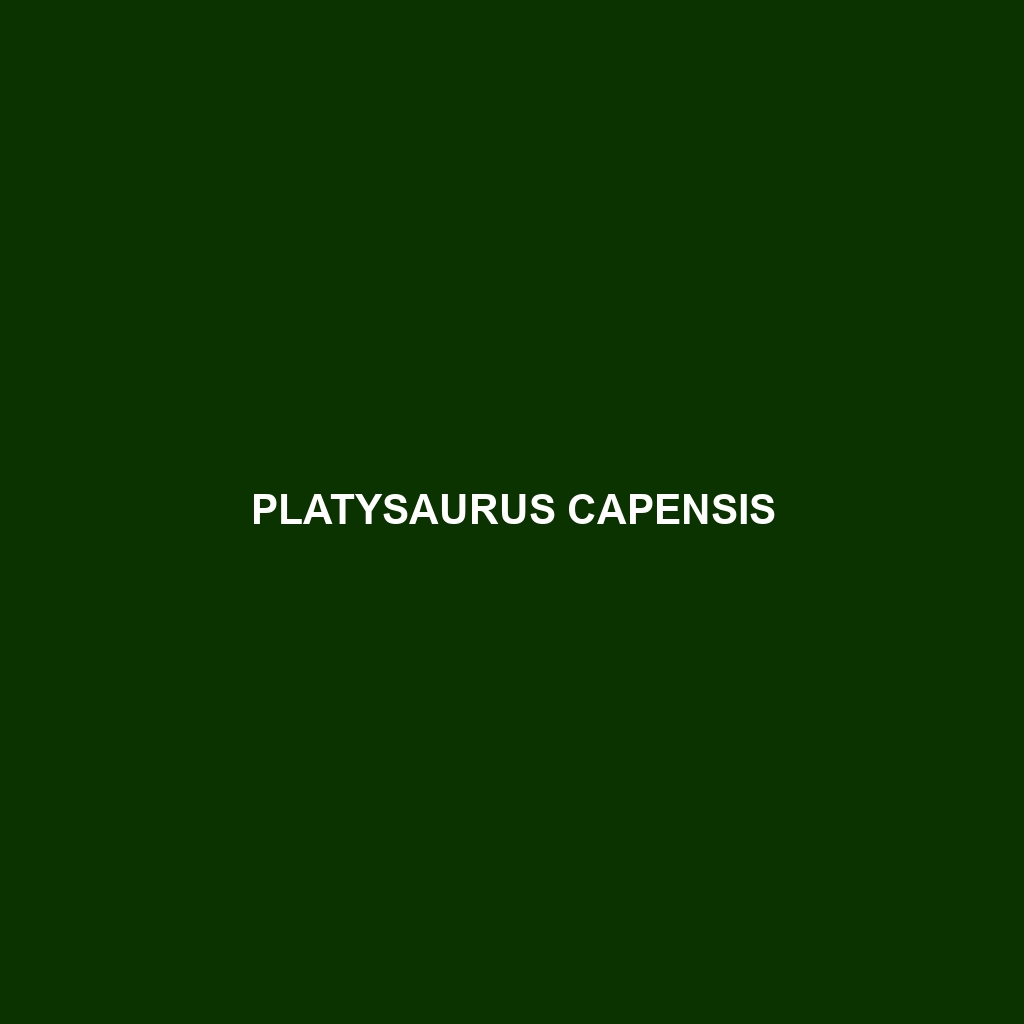Common Name
Platysaurus capensis
Scientific Name
Platysaurus capensis
Habitat
Platysaurus capensis, commonly known as the Cape flat lizard, is primarily found in the temperate forests and savannas of southern Africa, particularly in South Africa and Namibia. These lizards thrive in sun-drenched areas where they can bask on rocky outcrops and soil. They tend to inhabit environments that are warm and dry, often in regions with a Mediterranean climate. Due to their dependence on specific environmental conditions, these reptiles seek shelter in crevices, under rocks, and within dense foliage to avoid predators while maintaining access to sunlight for thermoregulation.
Physical Characteristics
The Cape flat lizard is a medium-sized lizard, typically measuring between 20 to 30 cm in length. It features a flattened body shape that facilitates its ability to move swiftly among rocks and underbrush. The dorsal side is adorned with stunning patterns that include shades of green and brown, which provide excellent camouflage against the earthy tones of the substrate. One of the distinctive characteristics of Platysaurus capensis is the pronounced dewlap in males, which plays a critical role in mating displays. Additionally, adult males generally exhibit more vibrant coloration than females, particularly during the breeding season.
Behavior
Platysaurus capensis exhibits various fascinating behaviors. Primarily diurnal, these lizards are most active during the daytime, particularly in the warm, sunny hours. They are known for their complex social interactions, especially during mating rituals where males engage in flashy displays of their colorful dewlaps to attract females. During the breeding season, aggressive territorial behaviors increase, with males often engaging in combat with rivals. Their ability to bask and regulate body temperature makes them adept hunters and valuable participants in their ecological niche.
Diet
As opportunistic feeders, Platysaurus capensis primarily consumes a variety of insects, classifying them as insectivores. Their diet includes ants, beetles, and grasshoppers, which are all abundant in their habitat. They sometimes supplement their diet with fruits and flowers, indicating a degree of omnivorous behavior. Their foraging strategy involves active pursuit and strategic ambush, utilizing their speed and agility to capture prey effectively.
Reproduction
The reproductive cycle of Platysaurus capensis is marked by a striking courtship process. Mating typically occurs in the spring, with females laying clutches of 2 to 5 eggs in sandy or moist substrates. The incubation period lasts around 2 to 3 months, after which the hatchlings emerge fully formed and scurry away from their nesting site to avoid predation. Parental care is minimal, as the young are independent from birth, relying on their instincts and learned behaviors to secure food and shelter.
Conservation Status
Currently, Platysaurus capensis is classified as Least Concern according to the IUCN Red List. However, habitat destruction, urbanization, and climate change pose threats to their populations and habitats. Conservation efforts are crucial to maintaining healthy ecosystems where these lizards thrive. Outreach programs and habitat restoration initiatives are being undertaken to ensure their long-term survival in the wild.
Interesting Facts
One intriguing fact about Platysaurus capensis is their remarkable adaptability to different environmental conditions. They can change their activity levels based on temperature, becoming more active during cooler mornings and evenings. Furthermore, these lizards are known for their unique ability to tolerate brief periods of dehydration, which enhances their survival in the often arid climates they inhabit.
Role in Ecosystem
Platysaurus capensis plays a significant role in their ecosystem as both predator and prey. As insectivores, they help control insect populations, which can impact plant health and reproduction. In turn, they serve as prey for larger birds and mammals, contributing to the food web dynamics. Additionally, their burrowing habits contribute to soil aeration, benefiting the overall health of their habitat. By maintaining these interactions, Cape flat lizards support a balanced ecosystem in their native range.
